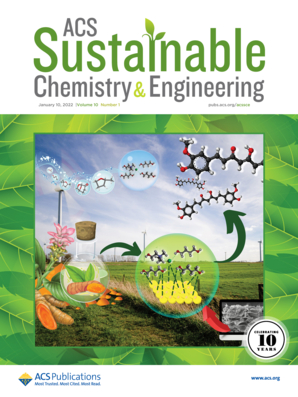IF 7.1
1区 化学
Q1 CHEMISTRY, MULTIDISCIPLINARY
引用次数: 0
摘要
淡水资源的匮乏对人类和社会的进步构成了重大挑战。虽然太阳能驱动的界面蒸发技术具有独特的优势,但光热材料的获取和制备极大地阻碍了该技术的进一步发展。在此,我们介绍了一种采用多孔沙盘(PSD)作为光热材料的新方法,该方法具有优异的蒸发性能。我们将天然砂转化为微米级的超亲水性 PSD,然后利用它设计了一种一维自供水 T 型蒸发器(T-PSD),其功能类似于植物蒸腾作用。T-PSD 在阳光照射下表面温度较低(36.5 °C)时的蒸发率为 1.428 kg/(m2-h),蒸发效率高达 86.1%。T-PSD 即使在蒸发盐水时也能保持较高的蒸发性能,这归功于 PSD 在边缘优先结晶。边缘优先结晶显著提高了蒸发器的连续运行能力。利用丰富且具有成本效益的天然砂作为光热材料,为推动界面蒸发技术的发展提供了一种可持续发展的方法。本文章由计算机程序翻译,如有差异,请以英文原文为准。

Porous Sand Disc: A Sustainable Approach for High-Efficiency Solar-Driven Evaporation
The scarcity of freshwater resources represents a significant challenge to the advancement of humanity and society. While solar-driven interfacial evaporation technology offers distinctive advantages, the acquisition and preparation of photothermal materials have significantly hindered its further development. Herein, we introduce a novel approach employing porous sand disc (PSD) as a photothermal material, showcasing exceptional evaporation performance. The natural sand is transformed into a micron-sized superhydrophilic PSD, which is then used to design a one-dimensional and self-water-supplied T-shaped evaporator (T-PSD), that is similar in function to plant transpiration. The T-PSD demonstrates a remarkable evaporation rate of 1.428 kg/(m2·h) with low surface temperature (36.5 °C) under 1 sun, resulting in an impressive evaporation efficiency of 86.1%. The T-PSD maintains a high evaporation performance even when evaporating salt water, attributed to the PSD crystallizing preferentially at the edge. The edge-preferential crystallization significantly enhances the evaporator’s continuous operational capability. Leveraging abundant and cost-effective natural sand as a photothermal material offers a sustainable development approach for advancing interfacial evaporation technology.
求助全文
通过发布文献求助,成功后即可免费获取论文全文。
去求助
来源期刊

ACS Sustainable Chemistry & Engineering
CHEMISTRY, MULTIDISCIPLINARY-ENGINEERING, CHEMICAL
CiteScore
13.80
自引率
4.80%
发文量
1470
审稿时长
1.7 months
期刊介绍:
ACS Sustainable Chemistry & Engineering is a prestigious weekly peer-reviewed scientific journal published by the American Chemical Society. Dedicated to advancing the principles of green chemistry and green engineering, it covers a wide array of research topics including green chemistry, green engineering, biomass, alternative energy, and life cycle assessment.
The journal welcomes submissions in various formats, including Letters, Articles, Features, and Perspectives (Reviews), that address the challenges of sustainability in the chemical enterprise and contribute to the advancement of sustainable practices. Join us in shaping the future of sustainable chemistry and engineering.
 求助内容:
求助内容: 应助结果提醒方式:
应助结果提醒方式:


